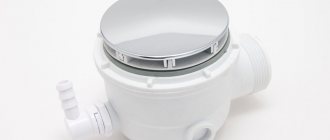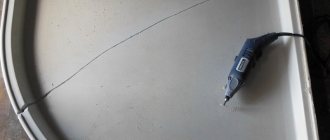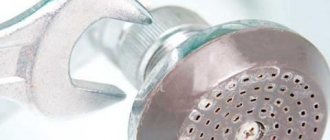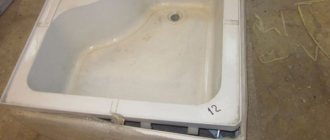The bathroom should be associated with cleanliness and order. But it happens that nauseating odors appear in the bathroom. There are many reasons for this, and one of them is the failure of the water seal. To have an idea of how to repair the system, you need to know the water seal design.
Diagram of the operating principle of the water seal.
How does a water seal work?
The fermentation process is the growth of a yeast colony. The yeast culture actively processes the sugars in the mash, decomposing them into ethanol and carbon dioxide. It must be diverted, leaving a way out for carbon dioxide so that it does not accumulate in the fermentation container. Otherwise, the most unpleasant consequences are possible, including the explosion of the mash under the pressure of the accumulated gas.
You can't leave the lid of the container open either. Oxygen from the surrounding air comes into contact with the mash and oxidizes it. As a result of this process you will get regular vinegar. The product is useful in the household, but not exactly what you would want from mash.
The solution to the problem of removing carbon dioxide and limiting the contact of mash with oxygen was a conventional water seal.
Main characteristics
A water seal is a pipe that is bent and constantly contains water. As a rule, water serves as a kind of barrier to gases; therefore, what is located on the other side of the drain hole should not penetrate into the room. A water seal is practically the same as a water seal and a siphon. If the water seal breaks, the siphon is without water. It can disappear slowly when the sewer system has not been used for a long time.
Types of drainage of water seals.
To prevent this from happening, in the event of a long absence, many recommend putting two drops of sunflower oil into the drain. It will create a kind of film, which will prevent evaporation.
When a metal siphon is installed, there is a very small bend in the elbow, the presence of water is small, which is why the valve can quickly break. To restore the valve, simply fill it with water. But this cannot continue for long, and in order to get rid of it, you need to investigate the cause of this phenomenon.
As a rule, the reason is that the outlet located at the top is blocked by some object or there is a plug in the pipeline itself. It may also happen that someone filled the exit hole with some kind of debris. It is not easy to deal with such problems on your own; you will have to contact a specialist.
Water seal designs
The design of the water seal includes two flasks, one of which is filled with water, and the second remains empty. Carbon dioxide freely leaves the mash, and oxygen cannot actively penetrate through the water barrier; as a result, the mash is protected from active oxidation.
An elastic stopper is used to attach the water seal to the container. It is made of rubber or silicone. The plug tightly seals the inlet. The escaping carbon dioxide freely leaves the mash, and the water chamber prevents the contact of oxygen and mash.
There are two main types of water seals.
- Non-removable water seal. In it, the cameras are connected in series and cannot be disconnected from each other.
- Demountable water seal. It is smaller in size due to the fact that the cameras are nested inside each other, like nesting dolls. The structure is disassembled, the inner chamber is removed.
Water seals can be sold as a separate option or included in the product package. For example, a barrel with a pneumatic lid is equipped with a water seal, which does not allow oxygen to penetrate into the barrel and come into contact with its contents.
There are lids for jars with built-in water seals. Their device is simple and effective.
- One end of the fixed hose is immersed in the jar, the other - in a small device on the lid, into which water is poured.
- Carbon dioxide comes out of the mash freely, and the water barrier does not allow oxygen to penetrate into the jar.
Such lids are convenient for those who prefer to store their mash in classic glass jars. The lid is compact and does not take up much space in terms of volume and height.
In a collapsible water seal, the chambers are nested inside each other
Element failure
To determine the failure, you need to listen to the sounds made when draining the water.
If the sound is loud enough and squelching, it means that the water seal has failed. Eliminating a breakdown is not an easy task. To do this, it will be necessary to examine the entire sewer system, since it happens that these problems cannot be solved without repairing some areas. Basically, to prevent such incidents from happening, it is important to consider the location of the water seal before purchasing plumbing fixtures. The most optimal height is considered to be 50-70 mm.
Scheme for cleaning the water seal.
If, after examining the sewer system, depressurization is discovered and because of this the bathroom begins to be filled with a sewer smell, you need to tighten all the fasteners and cover the affected area with sealant, or you can replace the rubber seals. With this whole procedure, the most unpleasant thing is discovering the problem.
This procedure is unpleasant due to the cramped space created, since in small bathtubs almost the entire space is filled with plumbing equipment. And water flows through the damage and seeps into the ceilings between floors.
Failure can occur from too long and inclined connections to plumbing equipment. In this case, when water is drained, the pressure in the pipes drops and the water seal with the pipeline operates on the principle of a siphon.
Most often, failure of water seals occurs in those plumbing fixtures that are located closer to the source of the blockage. In this situation, it is necessary to clean just above the device.
Replacing the siphon under the sink.
There are cases when a manufacturer makes defects when producing polyethylene bottle siphons, namely, they have a short partition. For this reason, the seal in the siphon is small and when water is drained into the sink, suction occurs from the water seal. And because of this, an unpleasant odor enters the bathroom. Such siphons cannot be repaired, and they only need to be replaced.
In addition to these problems, a water seal failure can also occur in the basement, and therefore odors can penetrate through the pipe into apartments. This comes from rarely using them. The greatest danger is the mixing of sewer gases and a gas pipeline, as this can lead to an explosion so strong that the entire residential building can be damaged.
If the small diameter of the riser also sometimes breaks the water seal, under other circumstances a partial blockage may simply occur.
How to choose a water seal
The basic operating principle is the same for all types of devices. They differ only in form factor. Therefore, the choice of a water seal depends more on the type of container on which you will use it.
- A lid with a water seal is suitable for a glass jar.
- For a barrel, you can use a pneumatic lid with a water seal.
- For plastic containers or glass bottles, you can use a collapsible or non-removable water seal. It is attached to a rubber lid and the containers are sealed with it.
Causes
Even modern sewage systems sometimes fail: the water in the bathroom does not drain well, an unpleasant odor appears, or worse, the toilet drain is clogged. Why doesn't the system cope with its functions?
Why does blockage occur?
Improper operation will affect stable operation. The problem is directly caused by:
- Household pollution. Particularly harmful are the fatty fractions deposited on the walls of the pipes. Hair and tissue fibers stick to such layers and accumulate in siphons, elbow bends, and pipe joints, forming a kind of mesh.
Hair is the most common source of problems. - High mineralization of water causes the deposition of salts in areas of variable cross-section, where the direction and flow velocity changes.
Limescale build-up. - Plumbing rust is retained by fat and hair plugs, forming an insurmountable barrier.
A plug of oxides and salts. - Accidental or intentional discharge of large food debris, household waste, rags, and household items into the sewer system.
Impenetrable "algae" - Backpressure . A clogged house sewer well is the cause of trouble for residents of the lower floors: the water does not drain, and what is drained from above ends up in your bathtub.
Do not dispose of construction waste through the toilet! A cement-lime suspension and fragments of materials, having accumulated at the lowest point, will completely block the riser.
Factors that have an indirect impact:
- No grids on the drains of sinks and bathtubs; installation of siphons without safety traps.
The result of operation without a strainer. - Route installation errors: non-compliance with recommended slopes and angles; narrowed internal passage.
The slope is not maintained.
Unacceptable bends in the corrugation.
This is not the way to lay a sleeve.
Organization of route turns.
The smaller the internal diameter of the pipeline, the greater the slope along the flow: from 0.02 (2 cm per 1 m) to 0.03 for diameters of 100 and 50 mm, respectively.
- coarse filter
Special cases
A cast iron pipe loses throughput faster than a plastic pipe due to corrosion, greater internal roughness, and the formation of differences in the interfaces of elements. Often they cannot be cleaned due to complete overgrowth and fragility of the walls, which are destroyed by weak impacts.
The likelihood of clogging a combined kitchen and toilet drain riser is higher than a separate one, since kitchen drains are saturated with fatty compounds. The network of the old building is not designed for the simultaneous operation of a dishwasher and washing machine; if the consumption exceeds the design, the water will drain slowly.
Individual sewerage systems for private housing are often equipped with a concrete pit. Due to poor waterproofing, when groundwater rises, the reservoir overflows, and sanitary waste has nowhere to go.
Modern septic tanks are equipped with insulated plastic tanks that prevent infiltration of perched water. Timely emptying of containers prevents stagnation in the bathroom.
There is no blockage, but the water does not drain
It happens that dirty water in the toilet or bathroom does not drain well when the pipes are not clogged. There are several options:
- The riser below the apartment tie-in is clogged . After filling the free volume of the pipe, the liquid stops passing.
- An air lock has formed . With intensive use of toilet and kitchen plumbing, the liquid, acting like a piston, captures air from the pipe, a vacuum occurs, the level of the toilet water seal drops, and rumbles from the neck of the bathtub. With the restoration of air pressure, the liquid that did not have time to escape is forced back. If the discharge of wastewater continues, the pressure does not have time to equalize with atmospheric pressure. The process becomes oscillatory and air pockets form. Closing the vent in the attic or roof leads to similar consequences.
- The membrane is jammed, the pendulum gate of the dry shutter is jammed: the locking mechanism partially blocks the passage, disassembly and repair are necessary.
Traffic jam areas
Pollution preferentially settles when the flow slows down. Stagnant pockets are especially susceptible to overgrowing: siphon elbows, cavities of eccentric transitions, corrugated hoses, sagging pipe strings.
Poorly made connections: misaligned, with burrs, squeezed out seals - potential obstacles for small particles and fibers. Rectangular shaped parts work like inertial mud traps: the flow hits an obstacle, turns 90˚, and the suspension loses speed and precipitates.
A clogged sewer riser causes great inconvenience. Coupling joints, connection to a basement sewer, and a manhole are likely places for deposits.
There is no alternative to replacement
Hydrodynamic ambulance
The safest, fastest and most effective in dealing with blockages is the hydrodynamic cleaning method. Its essence is that the debris plug is removed by the pressure of water supplied into the pipe. To do this, however, it is necessary to have a compressor device equipped with a set of special hoses.
Let’s say the owner of the “damaged” bathtub has such equipment, what should he do? Here are step-by-step instructions.
- Prepare the entire set for work.
- Remove the siphon from the drain pipe.
- Lower the hose into the pipe.
- Turn on the compressor device.
- Supply water under pressure.
- If water flows freely into the hole, you can turn off the compressor.
- If the plug does not go away, you should do the manipulation one more time.
Which is better: a homemade plug or a factory one?
A homemade stopper - disposable or reusable - will help out in those cases when you want to soak in a warm bath, but the old plug fell apart, cracked, began to leak water, or rolled somewhere.
Tips for making homemade traffic jams will also be useful to owners of rental housing who have rented an apartment for several days. In this case, there is no point in spending money on buying a new drain part.
Those who like to create home furnishings and other useful things for the home with their own hands can construct an unusual art object from transparent silicone.
In all other cases, it’s easier to go to the nearest hardware store and buy a factory plug. If you have a choice between plastic and rubber, then it is better to give preference to option 2: the rubber plug hermetically seals the drain hole and does not crack or crumble over time.
Bathroom stopper: 7 household problems with their solutions
What kind of bathtub plugs can you find on sale? Which ones are the most convenient and reliable? Finally, how can you plug a bathtub if there is no stopper? I am going to answer these and some other questions in my article.
Unusual stopper with a float.
Varieties
- What types of traffic jams are there??
Traditionally, this is a simple plug in the shape of a truncated cone, made of plastic, brass or rubber.
Brass plugs were used to complete cast iron bathtub fittings that were produced more than three decades ago. Nowadays they are found only in apartments of old houses, in which the plumbing has not changed during the entire period of their operation.
A metal chain (brass or stainless steel) is attached to its eye, with which you can remove the cork without getting your hands wet. However, some fittings (the so-called set of drain fittings for a bathtub) are somewhat more complicated:
- Trim - the machine allows you to open and close the drain by simply pressing it with your hand or foot;
Release of automatic strapping.
- Semi-automatic piping makes it possible to open and close the outlet from the bathtub by turning the decorative handle on the overflow.
- Which harness is more convenient and reliable??
In terms of convenience, in my opinion, the leader is the semi-automatic harness. Automatic plugs are less convenient, if only because the drain cannot be opened without getting your hand or foot wet. This is especially inconvenient when the bathtub is full of hot or ice water.
In terms of reliability, an equally undisputed leader is a harness with a separate plug on a chain. It is reliable precisely because it is extremely simple in design. Both competing solutions have their own vulnerabilities:
- For a semi-automatic plug, this is a cable connecting it to the handle on the overflow. After some time of use (usually 2-3 years), it begins to jam;
- For an automatic plug, the cause of failure is a breakdown of its fixation mechanism. It is not sold separately from the harness, which makes the maintainability of the entire structure zero.
The price of a plastic harness with a separate plug usually does not exceed 350 - 400 rubles. Metal strapping - a semi-automatic machine will cost the buyer at least 1,500.
Inexpensive and extremely reliable design.
- Which material is better - plastic or rubber??
Rubber. It is extremely rare for a plastic plug to seal the outlet completely hermetically. In addition, the rubber plug is easy to remove from the outlet if it gets stuck, but in the case of a plastic plug, removal sometimes results in a serious problem.
Our choice is a rubber stopper.
- How to remove a plug from a bathtub if it is tightly stuck in the outlet?
It all depends on its material and design.
The easiest way to do this is with a rubber plug: you just need to pick it up by the edge with a flat-head screwdriver.
This also applies to a metal plug with a rubber shell.
You can try to remove the plastic plug with the same screwdriver, alternately prying it from different sides.
If this does not help, a corkscrew for wine bottles can often save the situation: it is screwed into the cork, after which it is removed with some effort. Of course, after this you will need to go to the store to get a replacement for the damaged part.
Finally, if the corkscrew turns out to be powerless, you have to take radical measures: the cork is drilled in the middle and removed with pliers.
The biggest problem that can cause the owner is a brass plug stuck in the outlet of an old bathtub. Especially if the eye for the chain, which can be caught with pliers, is broken off. Sometimes it is possible to grab its edge with a gas wrench. If the key slips, you have to disassemble the outlet and knock out the plug from below, which is extremely inconvenient due to the tightness under the bathtub.
The worst case scenario is dismantling the cast iron outlet. In this case, it is easier to change the entire harness.
As a rule, cast iron trims are equipped with brass plugs. Here are some recommendations for dismantling them:
- First, disconnect the outlet from the tubular siphon by unscrewing the union nut on the connection. This can be done with a gas wrench No. 3 - No. 4;
- Try to unscrew the outlet by inserting open pliers into its grille. If necessary, use any lever inserted between their handles;
- If the outlet does not work, heat it from below with a hair dryer or blowtorch. Thermal expansion will do its job, and the thread will move.
If the semi-automatic piping drive or the piping latch breaks down, the plug will also remain in the outlet. You can try to swing it with a plunger and pry it off with a pair of screwdrivers or knives.
- How to make a new cork with your own hands?
If for some reason you don’t feel like checking out local plumbing stores, but have a tube of silicone sealant on hand, the instructions will be quite simple:
- Glue a paper mold for casting in the shape of a truncated cone with a glued bottom, the size corresponding to the outlet grille;
- Place a rope with a loop at the end or a chain into it;
- Fill the mold with sealant. After it dries, you will receive an original and durable cork.
Any object can be cast from sealant. You just need to make a mold.
- How to plug a bathtub if there is no plug for it?
If your bathtub outlet has a stainless mesh that protects the drain from hair and other debris, place a plastic bag under it. It will ensure the release is tight, and the mesh will prevent it from floating up.
The photo shows an improvised plug made from a mesh for release and a plastic bag.
- How to replace the plug in the bathroom if a mesh or other suitable weight is not at hand?
Here are some of the most obvious solutions:
- Wrinkle a dish sponge, place it in a plastic bag and plug the outlet;
- Fill the same bag with some water, tie it and place it on the grate in the bathtub outlet;
- Cover the outlet with a plastic cup or a wet rag folded several times.
The outlet grate can be plugged with any suitable object, as long as it does not allow water to pass through.
What can you use for a bath instead of a cork?
So, you decided to take a bath and discovered that the drain plug was missing. To cope with this annoying situation, use the means at hand. So, you may find it useful:
- Plastic bag. It must be clean. You need to put a small piece of fabric in the bag. Please note that the size of the fabric should only be slightly larger than the diameter of the water drain hole. The flap must be folded several times and placed inside polyethylene. The bag should be tightly tied and placed in the drain. When you start drawing water, the improvised plug will be sucked in and the water will not flow out.
- Foil. A piece of foil needs to be folded several times and plugged into the drain.
- Cup. You will need a plastic cup as the glass product may break. The glass must be installed in the hole, placing it upside down.
- Styrofoam. You should cut a piece exactly the size of the drain.
- Sock. The fastest and easiest way. Take one or more socks, scrunch them up, and plug the drain. You can also pour a small amount of sand into a sock and wrap it in plastic.
- Sponge for washing dishes. Fold it so that it fits into the drain, then wrap it in cellophane - the plug is ready.
- Newspaper, paper sheet. The option is fast, but short-lived. You will need newspaper or sheets of paper. Fold them tightly several times and place them in the water outlet.
Subject: Urgent! how to remove a plug from a bathroom?
Theme Options
My bathtub has such a modern mechanism - when the stainless steel stopper is lowered/closed by turning such a thing under the tap. Well, it was already broken, and this stainless steel plug (with a pin) was simply inserted and pulled out by a string.
And everything would be fine. But. I was spilled here, and in a hurry I closed the bathtub with a stopper so that I couldn’t open it; the string floated into the pipe, the stopper couldn’t be picked out.
I haven’t been able to drain the water for two days, and I’m starting to feel sad.
The owners once used something unknown to pick out this plug, but it was a long time ago, and they no longer remember with what or how exactly. But they remember that it was very long and tiring.
Help! What should I do? This lake in the bathroom is pretty boring
Cliosun
An ordinary dining room.
What was the rope clinging to? If there was a hole in the cork, you can hook it with a corkscrew.
Black Dembel
So the knife doesn’t fit into the gap at all, it doesn’t rise.
Thank you very much, I will certainly try again today.
the pin is inside, in the pipe. everything is absolutely smooth, so the tablet.
and what to drip with? water?
steel magnet should attract. no one goes to school? take a good magnet into the physics lab, apply it - the plug will stick to it with a magnetic field and come out, bringing the magnet back up
After removal, I recommend throwing it away and buying a cork stopper (like in a wine bottle), so that if something happens you can screw in the corkscrew
if you don’t want to, then drill a hole with a drill (by the way, if there is no magnet, you can try now), drill a hole with a good drill, screw a nail in with pliers and remove the plug.
Cliosun
, no, not with water, of course. household technical oil. Well, like for sewing machines or for lubricating door hinges. At worst, you can try using vegetable oil for this purpose. But I repeat once again - it would be good to wipe dry the place where the cork is before doing this. Also, preferably, in addition to the oil, you can try holding a piece of ice from the refrigerator on the cork. To cool the plug. Just do not press on it, otherwise it will jam even more.
Yes, and after dripping the oil, give it time to seep into the micro-cracks between the plug and the walls of the water drain. An hour or two should be enough.
Disassemble the drain under the bathtub and knock the plug out of there with anything, then immediately catch the correct string from outside and plug it back in (with the string) so that not the entire bathtub spills onto the floor
Then collect the drain back.
But this is not for such a beauty, of course
You can call a locksmith. He will come and do everything, but in 2-3-4 days.
You can also try picking it out with manicure gadgets.
get a guy for permanent residence
the cork will stick to it with a magnetic field and will come out, taking the magnet back up
so that if something happens you can screw in the corkscrew and screw in the nail with pliers,
they really say rightly: “keep quiet - you’ll pass for smart”
Honestly, I came home very late yesterday, so I didn’t try anything. Thank you all very much for your advice.
Serpent
it will be like “cutting off the head to remove the yoke from the neck”
Julian
the method is good, but inappropriate, the bottom of the bathtub is completely covered with tiles, these strange people didn’t even leave a window to crawl under.
snusmumr2
Here. looks like the truth.
where can I get such a hook? where are all kinds of construction and household items sold?
Cliosun
where can I get such a hook? where are all kinds of construction and household items sold?
Hmm.. I don’t know where this is sold in Moscow. Probably yes, in household goods or in the supermarket. There are different types of hooks with suction cups. A cheap option is just a suction cup and a metal one. wire in the shape of a hook. And there is a more expensive plastic hook that turns down and creates. Well, not a vacuum, of course, but a rather discharged space under the suction cup. These hold up very well. They will be easy to pull out the cork, and they will also be suitable for household use.
The bathtub below is completely covered with tiles, these strange people didn’t even leave a window to crawl under.
Usually 4 tiles are held on such a special device. sealant - mask the crawl space. In this case, you can cut out the sealant, remove the tile, repair it, and then do it as it was.
On guard - household chemicals
Blockages in bathroom pipes most often occur when small debris, hair, and pet hair collect in a “plug” at the elbow or at the joint.
Various household chemicals that contain alkali or acid will help eliminate the problem without much difficulty. Their choice is quite wide. The most popular are “Mole” and “Tiret”.
When purchasing a cleaning product, it is best to choose one that states that it is suitable for dissolving hair and fur, as well as what type of pipes it is suitable for.
How to get rid of mold and mildew in the bathroom?
Chemicals are available in liquid and powder form. By the way, “Mole” comes in both forms.
Having previously read the instructions, the solution, gel, powder or granules are poured/filled into the hole in the drain pipe. If the product used is not a liquid, be sure to pour one glass of warm water into the drain.
The “chemistry” is left in the pipes for the time specified in the instructions, and then washed abundantly with highly heated water.
Original household solutions
A traffic jam can be built in 1-2 minutes from small items that can be found in every apartment. The fastest, but one-time option is to crumple up newspaper or wrapping paper and plug the drain with it. To prevent the cellulose from getting wet and to last for 15-20 minutes, it must be compacted tightly into the drain hole.
You can use food foil in the same way: crumple a ball out of it, cover the drain with it, press down the foil and flatten it.
Homemade plugs, the manufacture of which requires plastic bags (bags), will last more than once:
- From a piece of thick foam plastic - packaging or sheet - cut a circle the size of which corresponds to the size of the drain. Pull a plastic bag over the improvised plug and release the air from it. Tie the free end of the bag into a knot.
- Fill an old but intact sock with sand or table salt. Make sure that the homemade plug matches the size of the hole in the bathtub. Place a plastic bag over it and tie it with a knot.
- Give the kitchen sponge for washing dishes the desired shape, stretch polyethylene over it and secure it with a tight knot.
- Take some water into a polyethylene or cellophane bag, tie it in a knot and place it on the drain grate.
Such devices will last longer if you use not 1, but 2-4 thin bags. Even if 1 of them breaks, the rest will protect the contents from getting wet and damaged.
You can also use the following as temporary placeholders:
- rubber, plastic or silicone children's toys of a suitable size;
- a plastic cup placed upside down on the drain;
- a wet rag folded in several layers.
If the drain is covered with a metal mesh that prevents hair and small debris from getting into the sewer, it can be used as a fixing weight. It is enough to place a bag or cellophane film under the mesh, and the improvised plug is ready.
How to make your own bath stopper
There are no limits to the imagination of home craftsmen - they can build a bathtub stopper with their own hands from anything. If you follow the instructions, you can make not just a stub, but an unusual art object:
- Cut a fragment from a thick wooden block to such a height that you can comfortably grab it with your hands when removing it from the drain hole. Grind the wood, giving it the shape of a cylinder. For a better fit to the walls of the drain, sand the edges of the cylinder with sandpaper. To make the wooden plug last longer, it is advisable to coat its surface with a hydrophobic impregnation.
- Connect several wine corks together, first cutting off their curves and fitting them tightly to each other. Fill all voids, gaps and cracks with silicone sealant. When the sealant has completely hardened, trim the edges of the structure and give the product a circle shape.
- Take an old flip-flop with a foam sole, a thick piece of rubber, or any unnecessary rubber product. Using a stationery or construction knife, cut out a round plug from it. Smooth the edges with sandpaper.
The water doesn't go away - why?
Often in everyday life a situation arises when the bathtub is clogged. How to clean it? The water stands in it, there doesn’t seem to be a blockage, and if there is, then all sorts of chemicals seem to be powerless.
Experts explain that the reason for this is the insufficient slope of the drainage system. It just needs to be increased, either by raising the bathtub, or by lowering the socket of the sewer riser.
Rules for cleaning the toilet in our article.











